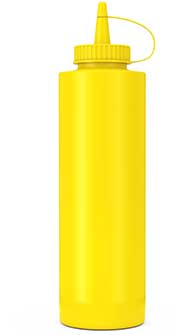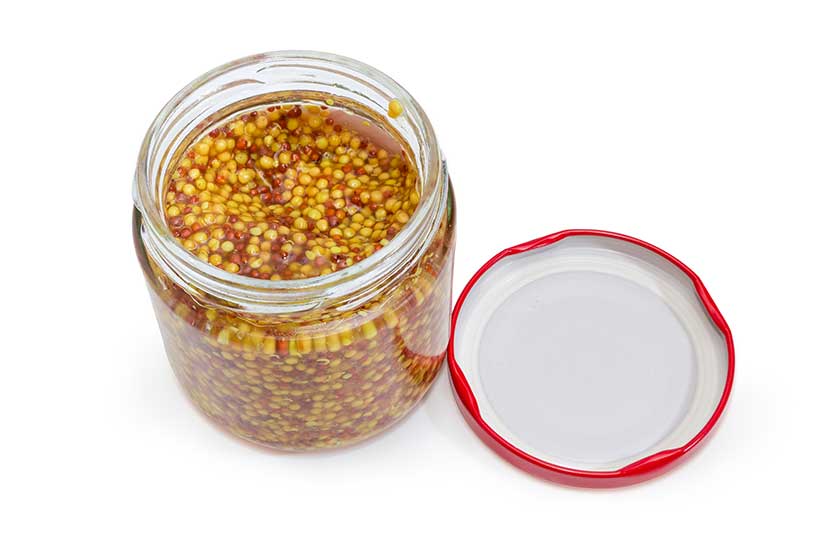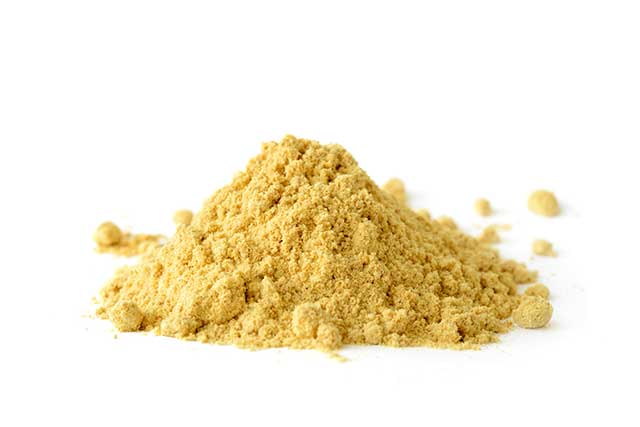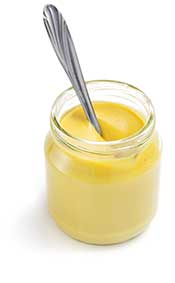
However, there are so many varieties of mustard that knowing the differences can be confusing.
This article provides a complete guide to prepared mustard; what it is, its nutritional properties, and the different types available.
Additionally, we’ll look at how to make homemade yellow mustard, which is much easier than most people assume.
What Is Prepared Mustard?
Prepared mustard is merely the spreadable condiment that we can buy in any store; it has been prepared already, and it is ready to use and eat.
The opposite of prepared mustard is dry mustard, which is otherwise known as “ground” mustard. This form of the condiment is still in its pure, unprepared state, and requires further preparation to make it into a spreadable form.
Yellow mustard is one kind of prepared mustard, but it is not the only one, and there are many different types.
The picture below shows whole grain Dijon mustard, which is another common variety;
What Is Prepared Mustard Made From?
Almost everyone knows that ketchup comes from tomatoes and mayo comes from eggs and oil, but where does mustard come from?
While they are not quite as famous as the source ingredients for other condiments, mustard seeds are the main ingredient in mustard.
However, how producers use the seeds depends on the variety of mustard they are making.
For example; whole grain mustard (as you saw in the above image) contains the seeds in their whole state.
On the other hand, the seeds need toasting and grinding into a fine powder to make yellow mustard.
Ingredients Profile
First of all, there are so many products out there, so there is no one single ingredients profile.
However, here is a fairly typical ingredients profile for yellow mustard and a wholegrain mustard;
| Yellow mustard | Water, vinegar, mustard seeds, salt, turmeric |
| Whole grain mustard | Mustard seeds, vinegar, water, salt |
There may be an additional spice or two such as paprika, but good quality mustard will generally have an ingredients profile like the above.
Watch out for brands that add sugar and vegetable oil; there is no need for these ingredients in traditional mustard, and they detract from the taste and health properties.
Prepared Mustard vs. Dry Mustard
As mentioned earlier, we can also buy mustard in its “dry” ground form.
Dry mustard is a coarse powder that works well as a flavoring spice. However, you will be disappointed if you try to use it in the same way as prepared mustard (don’t try).
Here are a few ways to use it;
- To flavor curries and stews
- Combine with salt, pepper, onion powder, and garlic powder as a dry rub for steak
- Deepen the flavor of sauce (this works particularly well with cheese sauces)
Compared to prepared mustard, this ground variety has a stronger and more powerful spicy taste. However, it lacks the tangy/acidic taste since it doesn’t contain vinegar as the spreadable form does.
Equivalent Amount In Recipes
If you are cooking and a recipe calls for dry mustard, then it is possible to use prepared mustard as a replacement.
There will be a slight difference in flavor due to the additional ingredients, but it will still taste good.
For this purpose, if a recipe requires one teaspoon of dry mustard, then an equivalent amount would be one tablespoon of prepared mustard.
The reason for the difference in quantity is because dry mustard is 100% pure, which results in a much more powerful flavor.
It is also possible to use this one tsp to one tbsp ratio at increasing amounts. For instance, two tablespoons of prepared mustard are equivalent to two teaspoons of the dry spice, and so on.
Typical Nutrition Profile
Generally speaking, we use mustard in small quantities, so it does not contribute a significant amount of nutrients to our diet.
However, for those who are curious, here is the nutrition profile of a standard jar of prepared mustard (1).
Calories and Macros
| Per 10 g serve | Per 100 g | |
| Calories | 6.7 kcal | 67 kcal |
| Carbohydrate | 0.53 g | 5.3 g |
| Fiber | 0.33 g | 3.3 g |
| Sugar | – | 0.9g |
| Fat | 0.4 g | 4.0 g |
| Saturated fat | – | 0.2 g |
| Monounsaturated fat | 0.26 g | 2.6 g |
| Polyunsaturated fat | 0.1 g | 1.0 g |
| Omega-3 | 48.8 mg | 488 mg |
| Omega-6 | 45.5 mg | 455 mg |
| Protein | 0.44 g | 4.4 g |
As shown in the table, mustard contains a relatively equal amount of all three macronutrients.
Additionally, it is a reasonably good source of ALA omega-3 fatty acids.
Vitamins (% DV)
| Per 10 g serve | Per 100 g | |
| Vitamin B1 | 2.3% | 23% |
| Vitamin B3 | – | 3% |
| Vitamin B5 | – | 3% |
| Vitamin B6 | – | 3% |
| Vitamin C | – | 2% |
| Vitamin D | – | 2% |
| Vitamin E | – | 2% |
| Vitamin B2 | – | 2% |
| Vitamin K | – | 2% |
| Folate | – | 2% |
| Vitamin A | – | 1% |
Aside from vitamin B1, prepared mustard is not a significant source of vitamins.
Minerals (% DV)
| Per 10 g serve | Per 100 g | |
| Sodium | 4.7% | 47% |
| Selenium | 4.7% | 47% |
| Manganese | 2.1% | 21% |
| Magnesium | 1.2% | 12% |
| Phosphorus | 1.1% | 11% |
| Iron | – | 8% |
| Calcium | – | 6% |
| Copper | – | 4% |
| Potassium | – | 4% |
| Zinc | – | 4% |
Prepared mustard contains a high amount of manganese, selenium, and sodium.
However, it is worth remembering that mustard is not a particularly good provider of nutrients since we eat it in small amounts.
Types of Prepared Mustard
While there are hundreds of unique varieties containing slightly different ingredients, here are some common types of prepared mustard.
 American Yellow Mustard
American Yellow Mustard
American yellow mustard is quite weak in flavor and often contains syrup, hence it offers a mild and smooth taste.
Since it only uses yellow mustard seeds (in addition to turmeric for coloring,) this spread has a bright yellow color.
Dijon Mustard
Dijon mustard is a traditional French mustard named after its place of origin.
It is similar to American yellow mustard, but it has a stronger flavor and more of a spicy kick.
Dijon often comes in whole grain form, which includes the whole seeds in the spread.
English Mustard
English mustard is the same as American mustard in most areas except one: the spice level.
The mild taste of the American version is gone and replaced by a hot-tasting experience.
French Mustard
Interestingly, French mustard is not actually French, and it is a product of the UK.
It is somewhat similar to American yellow mustard, and it was originally created as a milder substitute for the spicy original English variety.
Honey Mustard
Honey mustard is a sweet and mild version of the condiment, and it is often used in salad dressings and sandwiches.
Generally, the products we can find in-store contain a 1:1 ratio of mustard and honey.
For cheaper brands, it is likely that the mustard uses corn syrup rather than honey.
Hot Mustard
Hot mustard is a spicy condiment that is otherwise known as “Chinese mustard.”
This spicy spread is a simple mixture of dry mustard and water, but it may sometimes contain other ingredients such as vegetable oil or cayenne pepper.
This one is the hottest-tasting mustard you are likely to find.
Sweet Mustard
Hailing from Germany, the ingredients profile is generally similar to English and French mustards.
However, there is one big difference; this condiment contains more sugar than it does mustard, hence the sweet taste.
Other Mustard Varieties
In addition to the varieties listed above, there are all kinds of interesting mustard options.
Some of them contain sweet vegetables such as onions, and some are even made with beer instead of the traditional vinegar. That particular version is creatively titled “beer mustard.”
Benefits and Drawbacks
Since a typical serving ranges from five to 15 grams, any potential health benefits or drawbacks from mustard intake will be small.
However, here is a quick run-down of the pros and cons of using prepared mustard.
Benefits
- Tastes great
- Provides a good source of ALA omega-3, selenium, vitamin B1, and manganese
- Affordable
- Convenience – it is ready to use right away
Drawbacks
- Some brands use cheap filler ingredients such as vegetable oil
How To Make Homemade Yellow Mustard
For those that like making their own recipes, it is easy to make your own “prepared” yellow mustard at home.
The following three recipes require less than 10 minutes of total prep time.
1) Basic Mustard
To make a very basic spread, all you need are the following ingredients;
- 1/2 cup (120 ml) water
- 1/2 cup (55 g) dry mustard powder
- 1/4 cup (60 ml) white vinegar
- 1 tsp salt
- 1/2 tsp turmeric powder
To make this, just combine the ingredients and mix well until you have a smooth, consistent paste.
After this, put it in a jar and leave it for a few days to thicken and mellow.
2) Fruity Mustard
For a slightly sweeter variety, try the following ingredients;
- 1/2 cup (120 ml) water
- 1/2 cup (55 g) dry mustard powder
- 1 tbsp black mustard seeds
- 1/4 cup (60 ml) red wine vinegar
- 1/2 onion (sauteed)
- 1 tsp salt
First of all, chop half of a medium-sized onion into small, fine pieces and then saute them.
Once the sauteed onion cools, combine all ingredients, mix well, and then transfer to a glass jar.
3) Spicy Mustard
For those who like their mustard hot, here is a spicy recipe to enjoy;
- 1/2 cup (120 ml) water
- 3/4 cup (80 g) dry mustard powder
- 2 tbsp black mustard seeds
- 1/4 cup (60 ml) vinegar
- 1/2 onion (sauteed)
- 1 tsp salt
For this spicy mustard variety, combine the water, powder, vinegar, chopped onion and salt.
Add the mustard seeds last.
Next, mix everything well and transfer to a glass jar.
Final Thoughts
Prepared mustard is a tasty (and relatively healthy) condiment that can add an extra dimension to food.
It is available in all different varieties, and it only takes about 10 minutes to make some at home.
Give it a try!
For more delicious flavor-enhancers, see this article on the benefits of salsa.



 American Yellow Mustard
American Yellow Mustard